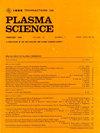Rice Seed Germination Improvement by Atmospheric Pressure Plasma Surface Modification With Water Buffer
IF 1.3
4区 物理与天体物理
Q3 PHYSICS, FLUIDS & PLASMAS
引用次数: 0
Abstract
Atmospheric pressure plasma (APP) treatment improves seed germination by introducing functional groups or etching to change its surface chemical characteristics. This study focuses on improving rice surface properties and reveals that water acting as a buffer plays a key role in APP treatment for the enhancement of seed germination. After a 150-s water buffer APP treatment, the germination percentage of rice seeds increased from 45% to 84% compared with the control group. This improvement can be attributed to the enrichment of surface polar functional groups resulting from the plasma treatment. Surface energy calculations revealed a remarkable increase in the polar component, leading to a substantial reduction in the water contact angle (WCA) from 105° to 40°. This indicates a significant enhancement in surface wettability, rendering it more hydrophilic. Consequently, water uptake from the seed surface also significantly increased. Moreover, X-ray photoelectron spectroscopy (XPS) showed that polar −NO functional groups were enhanced on the seed surface treated by APP with water buffer. The −NO functional groups were formed through a surface reaction between oxygen-excited species OH常压等离子体表面水缓冲改性提高水稻种子萌发率
大气压等离子体(APP)处理通过引入官能团或蚀刻来改变种子的表面化学特性,从而改善种子的萌发。本研究的重点是改善水稻的表面特性,并揭示了水作为缓冲剂在APP处理中对提高种子萌发起着关键作用。经150 s水缓冲APP处理后,水稻种子发芽率较对照组由45%提高到84%。这种改善可归因于等离子体处理导致的表面极性官能团的富集。表面能计算显示极性成分显著增加,导致水接触角(WCA)从105°大幅降低到40°。这表明表面润湿性显著增强,使其更亲水。因此,种子表面的吸水量也显著增加。此外,x射线光电子能谱(XPS)显示,经水缓冲剂处理的APP增强了种子表面的极性- NO官能团。在种子表面,氧激发态OH $^{\ast}$与N $ $_{2}^{+}$离子或N $ $_{2}^{\ast}$离子通过表面反应形成−NO官能团,可提高种子的润湿性,为种子萌发提供额外的营养。因此,用水缓冲液处理APP种子可以潜在地促进种子萌发。
本文章由计算机程序翻译,如有差异,请以英文原文为准。
求助全文
约1分钟内获得全文
求助全文
来源期刊

IEEE Transactions on Plasma Science
物理-物理:流体与等离子体
CiteScore
3.00
自引率
20.00%
发文量
538
审稿时长
3.8 months
期刊介绍:
The scope covers all aspects of the theory and application of plasma science. It includes the following areas: magnetohydrodynamics; thermionics and plasma diodes; basic plasma phenomena; gaseous electronics; microwave/plasma interaction; electron, ion, and plasma sources; space plasmas; intense electron and ion beams; laser-plasma interactions; plasma diagnostics; plasma chemistry and processing; solid-state plasmas; plasma heating; plasma for controlled fusion research; high energy density plasmas; industrial/commercial applications of plasma physics; plasma waves and instabilities; and high power microwave and submillimeter wave generation.
 求助内容:
求助内容: 应助结果提醒方式:
应助结果提醒方式:


